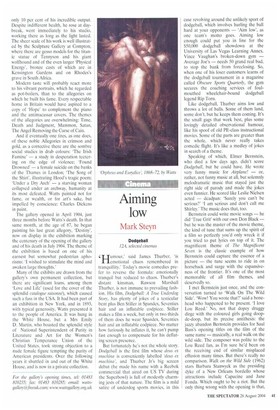Dickens in paint
Russell Chamberlin
The Vision of G.F. Watts: Centenary Exhibition The Watts Gallery, Compton, Surrey, until 31 October
The Watts Gallery is in the village of Compton in Surrey and is approachable by road. But if you have time try to approach it from the woodland path once known, romantically but erroneously, as the Pilgrims' Way, now correctly but boringly called the North Downs Trackway. The impact is unforgettable. You emerge from the green twilight into an English garden bright with flowers. The building, too, is quintessentially English: redbrick, low, rambling, festooned with creepers. But step inside and you are confronted with enormous Renaissance paintings, dubbed `Mega-Watts' by a wit, which would not be out of place in the Uffizi. They are the work of 'England's Michelangelo', George Frederick Watts, OM, and the gallery was opened exactly a century ago this year, built by his formidable second wife, Mary, as a permanent shrine to the artist she worshipped.
Throughout his long life (1817-1904) the gentle, lovable Watts drifted from one protective embrace to another. Even his disastrous first marriage to the 17-year-old Ellen Terry was arranged by another. Sara Prinsep, chatelaine of Little Holland House in London, exaggerated only a little when she remarked, 'He came for three days. He stayed for 30 years.' In 1886, at the age of 67, he married (or, to be exact, was married by) the 36-year-old Mary Fraser-Tytler, who then proceeded to make him her life's work. In 1891 she moved him to Compton, as much to get him out of the clutches of her rival, Mrs Russell Barrington, as to get him out of the London fogs.
The gallery houses some 300 of Watts's major works, in addition to his innumerable drawings, but even this represents only 10 per cent of his incredible output. Despite indifferent health, he rose at daybreak, went immediately to his studio, working there as long as the light lasted.
The sheer scale of his work is well illustrated by the Sculpture Gallery at Compton, where there are gesso models for the titan ic statue of Tennyson and his giant wolfhound and of the even larger Physical Energy', bronze casts of which are in Kensington Gardens and on Rhodes's grave in South Africa.
Modern taste will probably react more to his vibrant portraits, which he regarded as pot-boilers, than to the allegories on which he built his fame. Every respectable home in Britain would have aspired to a copy of 'Hope' to complement the piano and the antimacassar covers. The themes of the allegories are overwhelming: Time, Death and Judgment, Mammon, Satan, The Angel Removing the Curse of Cain.
And if eventually one tires, as one does, of these noble Allegories in crimson and gold, as a corrective there are the sombre social studies in drab colours: 'The Irish Famine' — a study in desperation teeter ing on the edge of violence; 'Found Drowned' — a female suicide on the banks of the Thames in London; 'The Song of the Shirt', illustrating Hood's tragic poem;
'Under a Dry Arch. — a starving woman collapsed under an archway, humanity at
its most defeated. Watts painted not for fame, or wealth, or for art's sake, but impelled by conscience: Charles Dickens in paint.
The gallery opened in April 1904, just three months before Watts's death. In that same month, at the age of 87, he began painting his last great allegory, 'Destiny', now on display in the exhibition marking the centenary of the opening of the gallery and of his death in July 1904. The theme of the exhibition is based on one of his earnest but somewhat pedestrian aphorisms: 'I wished to stimulate the mind and awaken large thoughts.'
Many of the exhibits are drawn from the gallery's own permanent collection, but there are significant loans, among them 'Love and Life' (used for the cover of the splendid catalogue raisonne), which caused such a fuss in the USA. It had been part of an exhibition in New York, and in 1893, with typical generosity, Watts presented it to the people of America. It was hung in the White House, but a Mrs Emily D. Martin, who boasted the splendid style of National Superintendent of Purity in Literature and Art for the Women's Christian Temperance Union of the United States, took strong objection to a nude female figure tempting the purity of American presidents. Over the following years it shuttled in and out of the White House, and is now in a private collection.
For the gallery's opening times, tel: 01483 810235; fax: 01483 810285; email: wattsgalleryg.freeuk. com; www.wattsgallery.org.uk



























































 Previous page
Previous page